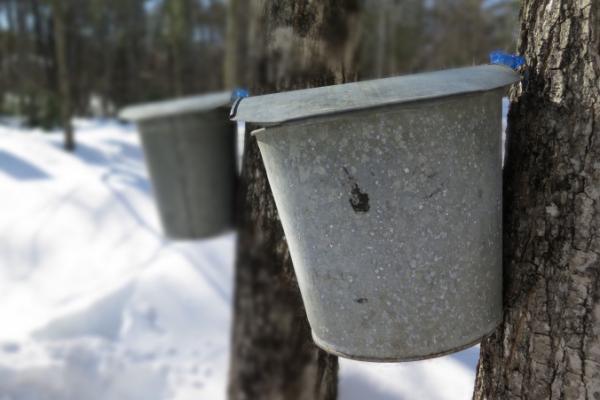If you listen, each bucket has its own special sound. First are the empty buckets and their muted ting of dripping sap falling straight to the galvanized steel bottom. Next is the dop that reverberates from the slightly sweet drop running off the spile to a thin layer of liquid below. But it is the soft, and all too rare and timeless plop that I wait for. That quiet plop (or sometimes plip) signals that over half of that the three-gallon bucket is full and the tap is giving in abundance.
There is a slight quickening of the heart when the bucket is heavy enough to need two hands to pull off the hook. Then an involuntary smile to hear the pitch of the shwoosh ascend as the smaller bucket presents it’s offering to the larger. But sometimes, before I touch the bucket at all, I stop and wait to hear what it has to say. Ting? Dop? Plip? Plop?
I look at the tree and then its neighbors. I strain to hear the rhythm of the buckets around me and wonder, what makes one tap run so well when others are nearly dry?
The ache in my shoulders as I carry my harvesting buckets is a sign of the trees’ largess. My helper, Pippa, runs up ahead and I wonder how she might do next year with a harness and a sled. But her mother, my sister-in-law, would never allow it. “Draft horses,” she would say, “Let’s save up for draft horses instead.”
My brother and I debate our tubing systems versus our buckets. We both understand the benefits of the natural vacuum created by the web of taps and tubes all feeding into one large drum. Still, we hypothesize, all that sap traveling through the plastic might leave a taste. This thought may or may not be true, but it might just push us to realize our vision for a hillside of silver pails hanging as glinting adornments on our maturing sugar bush.
The moment that is hardest to hear, but for which I am training my ears, is the relinquishing of my harvest to its final 250-gallon holding tank. My brother built a stairway of logs up to the side of this storage place. But soon, he says, we’ll prepare our grandfather’s old stainless steel dairy tank for the job. Until then, we’ll have to settle for plastic.
With my bucket, I climb the steps that, until a few days ago, had been mostly unnecessary because of the height of the snow. I rest the bucket on top of the container that reaches to my shoulders even from my elevated position. The cap unscrews easily, I wait until there is no wind and begin to pour.
The drop of the liquid at first was nearly five feet. Each day it is getting less. Every time I pour another bucket, the sound changes. It is the loudest moment in this movement of sap but the hardest to distinguish these nuances.
I make a new commitment.
There are connoisseurs of paintings and sculptures. There are experts of wine and food. There are scholars of prose and poetry. Each spends their life in pursuit of an increasingly fine-tuned sense for their subject, and this (I hope) is because that thing might make them happy.
But I have to wonder, do they pay so much attention to that thing because it makes them happy? Or does that thing make them happy because they pay it so much attention? Do they look because it is fascinating or are they fascinated because they learn to look well?
If I gave the attention — and affection — to the pouring of these buckets as the collector gives to their paintings, the oenophile to their drink, and the reader to their verse, could I find their happiness? Could I find more?
Joy after all, does not make its home in things but jumps out into the space between them. Joy is found, discovered, and unwrapped. It finds its existence not as an object but as a gift always being given. It is does not need to be dulled by repetition but can find its life most fully as it is practiced daily.
There is efficiency in the tubing, to be certain. We might always have some around as a testament to the limits of our shoulders. But I believe there is joy to be found in the sound of those buckets. So I will listen, and try to find a name for, the sounds of each one I pour.
Timothy King formerly served as Sojourners’ Chief Strategy Officer and now writes and farms in New Hampshire. You can read his thoughts on farming, food, and faith at his blog, Almost Home.
Got something to say about what you're reading? We value your feedback!
